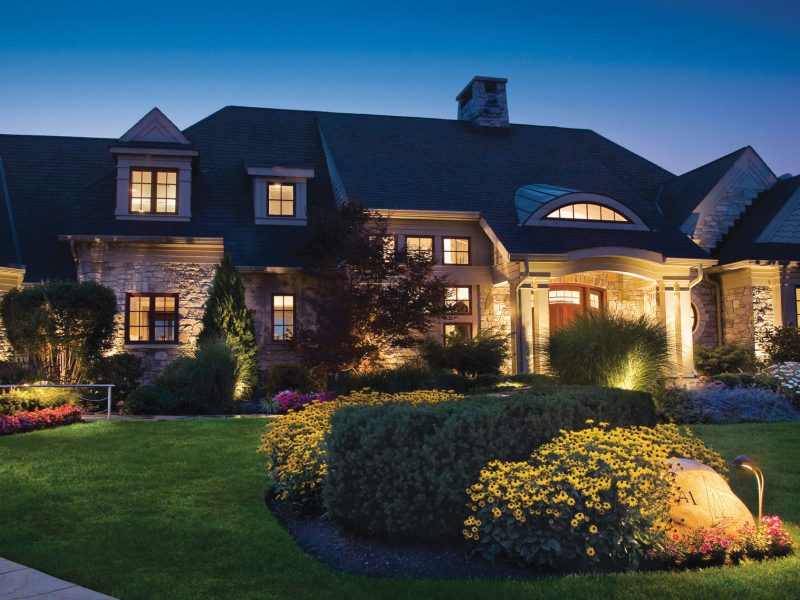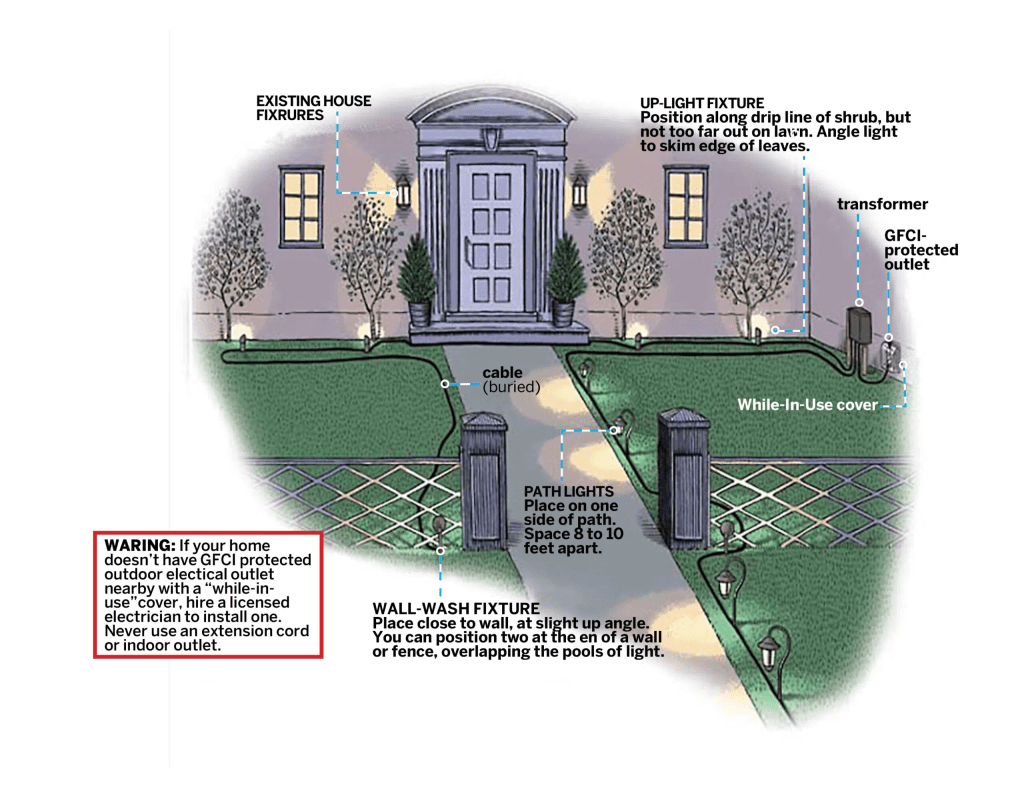
For many homes, lighting landscape can create an enchanting atmosphere at night, typically positioned along walkways and driveways, but is also ideal for illuminating staircases, trees, stone walls, railings, and other prominent landscape features. Also, landscape lighting adds personal safety for walking, and it increases around the home area. Here’s a beginner’s guide to help you install landscape lighting.
Before You Begin
Choose your lighting type. Decide which of the three types of landscape lighting is best for your home: solar lighting, low voltage lighting, or line voltage lighting. Install any one of these systems by itself or combine them as needed. The below tables are the pros and cons of each type of landscape lighting.
Solar Landscape Lighting
PROS:
- Rechargeable
- Inexpensive
- Able place anywhere
CONS:
- Dim lights (ranging 10 to 55 lumens)
- Fade out at night
- Sunny areas only
Line Voltage Landscape Lighting
PROS:
- Protected cable
- Higher power
- Brighter light (with 120V power)
CONS:
- Separate materials, no kit
- Hard to move or alter
- More difficult to install
Low Voltage Landscape Lighting
PROS:
- Timer scheduling
- Moveable
- Consistent light (120V to 12V or 24 V)
CONS:
- Light connections balky
- Light limits per cable
- Cable length limit
Tools and Material You’ll Need
Tools:
- Shovel or trenching tool
- Wire strippers
- Wire connectors (gel-filled or waterproof)
Materials:
- Landscape lighting fixtures
- Low-voltage transformer
- PVC conduit (if required by local codes)
- Electrical cables (direct burial or landscape lighting cable)
- Timer (optional)
- Voltage tester
Step-by-step instructions
1. Plan your lighting layout

- Decide which areas to highlight with landscape lightings, such as pathways, plants, trees, or architectural features.
- Sketch a lighting plan, marking where to install lighting fixtures and the cable paths from the transformer to each fixture.
2. Choose lighting fixtures
- Select the appropriate lighting fixtures based on your desired effect and the features you want to illuminate.
- Consider brightness, beam angle, and bulb type (LEDs are energy-efficient and long-lasting).
3. Install the transformer
- Choose a suitable location near an outdoor power source for the low-voltage transformer. Ensure it is protected from the elements.
- Connect the transformer to the outdoor power source following the manufacturer’s instructions.
- If local codes require, use a PVC conduit to protect the wiring from the transformer to the first lighting fixture.
4. Lay out the cables
- Determine the cable path from the transformer to each lighting fixture, following your lighting plan.
- Use a shovel or trenching tool to dig a shallow trench along the cable path. The depth should be sufficient to bury the cable but comply with local codes.
- Place the cable in the trench, ensuring it is properly positioned and free from any kinks or sharp bends.
- Use waterproof wire connectors to join them securely if multiple cables are needed.
5. Connect the fixtures
- At each lighting fixture location, strip the insulation from the ends of the cable using wire strippers.
- Follow the manufacturer’s instructions to connect the lighting fixture’s wires to the cable’s corresponding wires.
- Use waterproof wire connectors or gel-filled connectors to make secure and watertight connections.
6. Bury the cables
- Once all the fixtures are connected, carefully bury the cables in the trench using a shovel.
- Ensure the cables are buried appropriately and comply with local codes and regulations.
- Avoid any sharp bends or kinks in the cables to prevent damage.
7. Test the system
- Before covering the cables, use a voltage tester to ensure the correct voltage reaches each lighting fixture.
- Turn on the transformer and verify that all the lights are functioning correctly.
- Make any necessary adjustments to the fixture positions or connections to ensure optimal lighting effects.
8. Install a timer (optional)
- To control the operation of your landscape lighting, consider installing a timer. Timers allow you to set specific on/off schedules for your lights.
- Follow the manufacturer’s instructions to install and program the timer according to your preferences.
Always ensure safety and follow local electrical codes and regulations when working with landscape lighting installations. If you’re unsure about any aspect of the installation, it’s best to consult a professional electrician or lighting specialist for guidance.

Comments